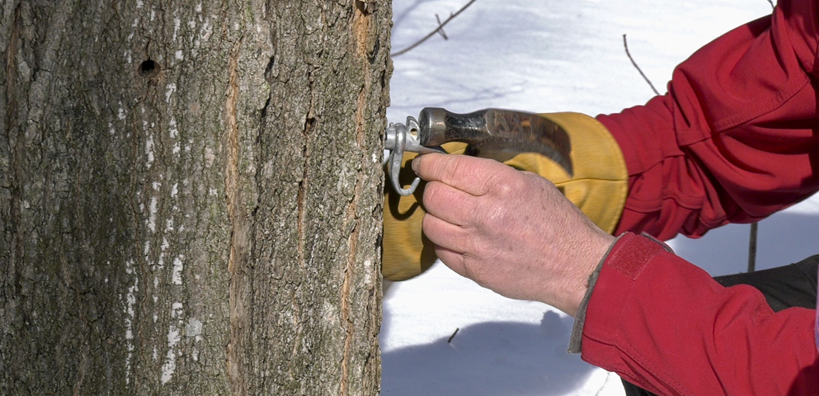Quebec maple syrup producers using gold nanoparticles to test quality
 Tapping a maple syrup tree at Elsie's Creek Farm in Coldwater, Ont., on Thursday, March 4, 2022 (Steve Mansbridge/CTV News)
Tapping a maple syrup tree at Elsie's Creek Farm in Coldwater, Ont., on Thursday, March 4, 2022 (Steve Mansbridge/CTV News)
The maple syrup we pour on our pancakes is the product of high-precision work, and its quality is scrupulously inspected before it's sold.
But sometimes, unwanted flavours can creep into the syrup and lessen its grade, much to the chagrin of maple syrup producers.
Fortunately, researchers at the Université de Montréal (UdeM), in collaboration with the Producteurs et Producrices acéricoles du Québec (PPAQ) and producers in the field, have developed an easy way to test the sap using gold particles and nanotechnology.
Gold particles as thin as one-hundredth the width of a hair turn red in the liquid where they rest. But when maple sap is added, the liquid turns blue.
"It's like a pH test, or a chlorine test for the pool," explains UdeM chemistry professor Jean-Francois Masson, who co-created the COLORI test.
The more drops you can add before the colour changes, the more likely the syrup will be of good quality.
This year, 250 seasonal kits were distributed as part of a pilot project, and researchers expect to invest more widely in 2024.
The technology allows producers to test for quality before "putting a lot of energy and time" into making their syrup, said PPAQ spokesperson Joël Vaudeville.
They can also sample and compare sap from different trees on the often-large properties.
Vaudeville says the test is "very simple to use" on-site, and an analysis grid is provided so producers can interpret the results themselves.
"It allows them to make business decisions."
According to the Canadian Food Inspection Agency, flavour defects "can be a trace of caramel, which is more common in amber or dark syrup, or a trace of sap of bud, which is more common in late-season syrups," among other things.
Defective syrups are usually used exclusively in processing plants and kept off store shelves.
There are four main classes of syrup. Golden, with a delicate taste, comes with the beginning of the maple season. As time progresses, the colour becomes darker and the taste more pronounced.
"With climate change, spring weather has become very variable," said Masson, adding that for the past ten years, producers have increasingly found "atypical flavour profiles," especially at the end of the season.
Research to further the test was published in the journal ACS Food Science & Technology.
This report by The Canadian Press was first published in French on Marh 26, 2023.
CTVNews.ca Top Stories

From outer space? Sask. farmers baffled after discovering strange wreckage in field
A family of fifth generation farmers from Ituna, Sask. are trying to find answers after discovering several strange objects lying on their land.
Broadcaster and commentator Rex Murphy dead at 77: National Post
The National Post is reporting that Rex Murphy, the pundit and columnist who hosted a national call-in radio show for decades, has died.
Pearson gold heist suspect arrested after flying into Toronto from India
Another suspect is in custody in connection with the gold heist at Toronto Pearson International Airport last year, police say.
Millions of cyberattacks per hour as B.C. government investigates multiple breaches
Careful attention to government statements and legislation is required to get a handle on the level of risk British Columbians’ information is under, as investigators probe multiple breaches under a continued barrage of attacks.
Ontario family receives massive hospital bill as part of LTC law, refuses to pay
A southwestern Ontario woman has received an $8,400 bill from a hospital in Windsor, Ont., after she refused to put her mother in a nursing home she hated -- and she says she has no intention of paying it.
Debate on abortion rights erupts on Parliament Hill, Poilievre vows he won't legislate
A Conservative government led by Pierre Poilievre would not legislate on, nor use the notwithstanding clause, on abortion, his office says, as anti-abortion protesters gather on Parliament Hill.
Justin and Hailey Bieber are expecting their first child together
Hailey and Justin Bieber are going to be parents. The couple announced the news on Thursday on Instagram, both sharing a video that showcases Hailey Bieber's growing belly.
Here are the ultraprocessed foods you most need to avoid, according to a 30-year study
Studies have shown that ultraprocessed foods can have a detrimental impact on health. But 30 years of research show they don’t all have the same impact.
New 'Lord of the Rings' film coming in 2026
The Oscar-winning team behind the nearly US$6 billion blockbuster 'Lord of the Rings' and 'The Hobbit' trilogies is reuniting to produce two new films.

































